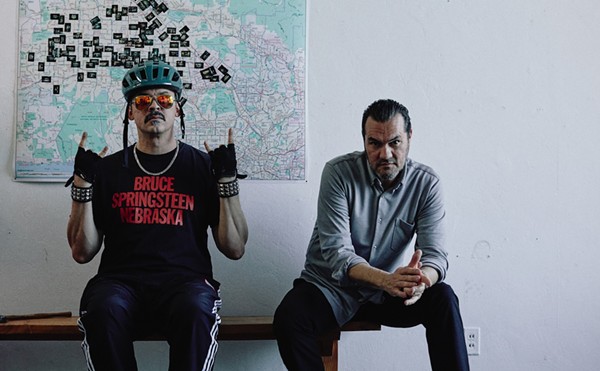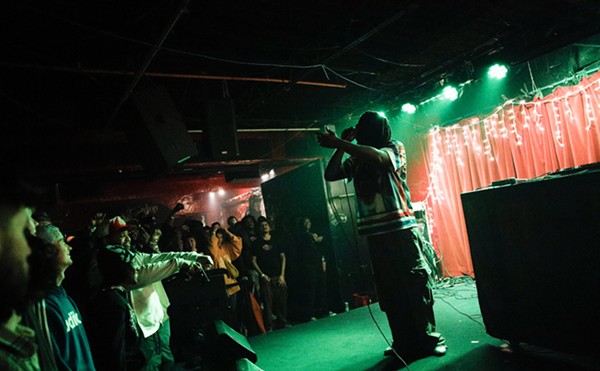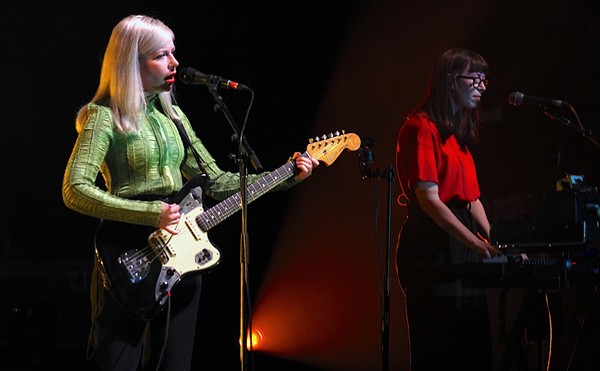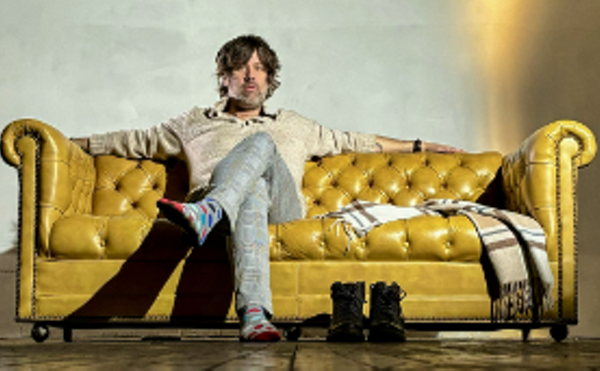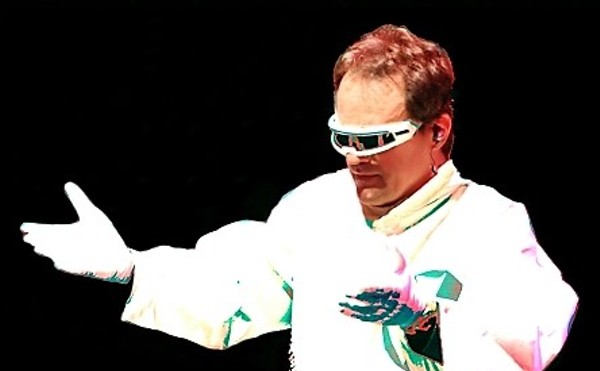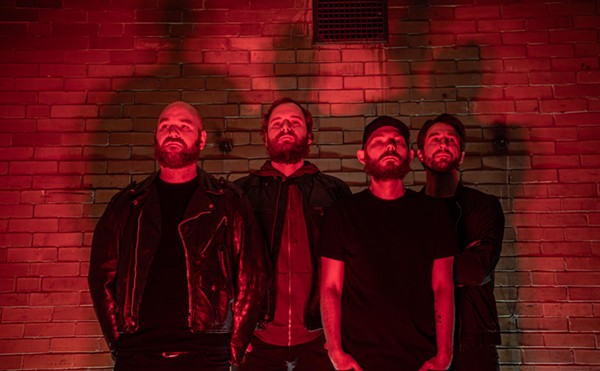[
{
"name": "Ad - NativeInline - Injected",
"component": "38482495",
"insertPoint": "3",
"requiredCountToDisplay": "5"
},{
"name": "Real 1 Player (r2) - Inline",
"component": "38482494",
"insertPoint": "2/3",
"requiredCountToDisplay": "9"
}
]
We’re celebrating the 50th anniversary of WMMS with an oral history that’s this week’s cover story. A big part of the station’s legacy has been the Buzzard. While other radio stations have had well-known mascots over the years, it can be argued that none of them, or at the least, very few, had the national — and international impact of the Buzzard. Witness the mid-’90s when the station went online with its first website, and received email requests for songs as far away as Japan. To this day, if you happen to be traveling and in an airport in another city wearing a WMMS T-shirt, chances are good that someone will stop you and ask, “Where did you get that shirt and how can I get one?”
The story of the Buzzard begins officially as former WMMS programmer John Gorman recollects in his book, with a complaint letter from David Helton, who had moved to Cleveland and was working at American Greetings. He was upset that in his view, the station had truncated their regular broadcast of the National Lampoon Radio Hour from an hour to a half-hour. As it turns out, it was something of a prank by the radio show itself. But it was enough to make a number of people, including Helton, upset. As Helton tells Scene now, “sending in a ‘comment card’ in the form of a comic strip protesting the station’s programming” was something that came naturally to him. When he grew up in the Southeast, he would send cartoons related to rock 'n' roll music to the DJs.
“I sometimes think that it was the rock 'n' roll that urged me to do it and maybe that same music is what motivated John [Gorman] and Denny Sanders' response to my submission and their love of radio,” says Helton.
The move was one that got the attention of Gorman and Sanders, and they knew they had found their artist to create the new logo they were envisioning to replace the mushroom logo the station was using at the time.
“The Buzzard evolved from an ongoing conversation Denny and I had about sports team mascots and logos and applying it to our radio station,” Gorman recalls in a separate interview. According to Gorman, the character made its debut on April 16, 1974 in the alternative weekly Zeppelin. The development of the Buzzard logo was something that played out in an evolutionary fashion, at the same time that the station itself was continuing to evolve.
“The development of the Buzzard character was synchronized to the ongoing development of WMMS, but we didn’t consciously realize it at the time,” Gorman says now. “The Buzzard started out as a mean looking bird with facial hair and a long neck. As time went on, the Buzzard spruced up its appearance and got a shave and a haircut. But that gleam in his eyes and that confident smile remained the same.”
More than that, Gorman sees a further meaning in the flight path of the Buzzard, which “developed from a carnivorous bird of prey circling a dying city with no hope to a symbol of youth and rock 'n' roll.”
Helton admits that his lifelong sidekick had quirks, some of which came as a result of his own development as an artist, which was still in process at the time he created the character.
“The Buzzard is an oddly drawn fellow — some of my peers say he's hard to draw for them — but of course it came gradually as well. As I grew as an artist and cartoonist and being young I had many influences,” Helton explains. “The Buzzard started out looking like an 'underground comix' [a series of socially and politically influenced comic books that were produced in limited numbers and most popular in the early ‘70s] character because I was highly influenced by Crumb, Lynch and other underground comix artists.”
Interestingly, and perhaps not surprisingly, Helton says that there were multiple layers of comedy — radio, movies, TV and comedians — which helped nurture his growth. “I had other influences like comic artists Frank Frazetta, Gil Kane, Chuck Jones and the Warners' cartoons, plus many others,” he says. “Comedy greats also helped not with my art style but my 'cartoon sense of humor.' W.C. Fields, Laurel and Hardy, Jack Benny and other radio, movie and tv comedy greats. Also, my skills using traditional comic book tools like brushes, ink and pen points, crow-quills and others were getting better, and I wanted a 'cleaner' look to my art and the Buzzard was refined to a more simple and powerful image very naturally.”
The Buzzard has been used on countless items across the years — an unbelievably diverse spread of t-shirt designs, bumper stickers, glasses, coffee mugs, billboards and even several different types of vehicles that were given away to radio station contest winners. But internally, the life of the radio station was being tracked in the ‘70s with the publication of The Buzzard News.
“It’s all of the inside stories. It’s hysterical and amazing,” ‘70s WMMS music director and air personality Shelley Stile recalls. “The Buzzard News was an inside [publication]. We also gave it to the record people, but it told all of the stories of what was going on inside the station. It was incredible.”
“We'd boost morale and excitement with the air staff by doing funny cartoon memos about our 'enemy,' the sales staff. It was a joke but we made fun of how square the suits were and all in good fun,” Helton remembers now. “They were good sports about it because they knew they were making all the big bucks. Eventually the ideas were so abundant that we expanded The Buzzard News into stories featuring the Buzzard as the leader of the Buzzard Nuclear Army air staff that battled against 'bad radio' and created foes out of our competition at other stations. We probably did about 12-15 'issues' copied off secretly using the corporate copiers after hours.”
As the Buzzard moved into the ‘90s, he was heading for an unexpected barbershop appointment that would find him emerging with a spiky new haircut. As you can imagine, it was something that was controversial at the time and opinions were split. Michael Luczak was the program director for WMMS in that era and had done a stint at legendary Cincinnati rock station WEBN. Their longtime mascot, the Frog, first made an appearance on a T-shirt in the ‘70s, helping to sell the station’s fictional beer, Tree Frog Brew, which featured the slogan, “It doesn’t taste like much, but it gets you there quicker.” The character became very popular, but as Luczak recalls, the image of the Frog was one that wasn’t locked in time.
“You can look at the Frog and every couple of years, it had a different kind of spin. It wasn’t the same iconic Mickey Mouse thing that looked the same for 25 years. And I thought it would just be a good thing to do to contemporize it a little bit more,” he says now. “I don’t think it really made a bit of difference to the general public. I think as long as we still had the name, the Buzzard and you saw the picture with the claws and the wings, you know, that’s pretty much all you needed.”
Helton had exited the station by this time and had been replaced by his longtime associate, Brian Chalmers, who was well-suited for the role as someone who had a similar reverence for the history of the station and getting it right, making sure that the brand was properly represented. Helton and Chalmers had first connected in the '70s when Chalmers was the art director for Scene.
“Brian was also kind of like me in that he was a very loyal person. If you had him as a friend, he was your friend. There was no doubt about it,” Helton says. “He’d do anything for you if you ask him. He’s just that kind of person. He was a very loyal type of friend. With that, he was true to the legend of 'MMS, I suppose. When he came along, he saw that the formula for success with 'MMS, he saw people trying other things or saying, 'No, that costs too much money, we can’t do that.' Brian would go, 'Well, it’s worth it, though'.”
For the longtime illustrator, seeing the Buzzard’s new 'do was a moment that stung.
“I was disappointed in it. Here they are; they’ve already got ratings falling, and they think it’s the Buzzard. So, changing the Buzzard is going to bring their ratings up. No, that’s not going to do it. You’re fucking up a lot of other ways,” Helton says. “They’re going to blame it on the image? Gimme a break. This is an established image. I didn’t like it, Brian didn’t like it either. But I understood also that Brian had to do it his way. He did it his way and I understood that. However, he was being dictated to.”
Luczak acknowledges now that he realizes there were probably differences of opinion regarding the move, but says that he didn’t feel resistance at that time.
“If I had come in there and said, 'We’re getting rid of the Buzzard,' they would have shot me,” he laughs. “But I’m sure it was divided in the building. I’m sure that some people liked it [and some people didn’t]. John Chaffee never got enough credit, I think, for what he was doing. He was behind the scenes as the president of Malrite when I got there and John had come to Cleveland with Milton Maltz back when they first came in. He was a copywriter and then he worked his way up. He was my immediate boss and he was all for [the changes to the Buzzard]. He didn’t say, 'Gee, Michael, I don’t think you should do that'.”
In 1994 with the return of Gorman and the arrival of the “Next Generation,” the Buzzard was back flying high again with his signature look restored. While the futuristic tone of the station’s positioning and the focus on new music directionally could have inspired a space-age Buzzard, he instead looked more familiar. That made perfect sense to Gorman as he was thinking about the image of the new station.
“It’s like, we’re a different country than we were a hundred years ago, but we still have the same flag. That was kind of the way I looked at it. I was no longer at ‘MMS when they changed to that 'Cocoa Puffs’ bird. I was appalled by it. I thought it was terrible. I know why it was done — they were trying to update the image, but it wasn’t the image that needed updating, it was the programming. I thought it was a bad mistake,” he says. “One of the first things I thought about, even before that whole Next Generation idea, was, ‘We’ve got to bring back the original Buzzard. That Cocoa Puffs bird — that’s not us.’ That’s never the way I envisioned the station. We wanted to bring back the original Buzzard, you know, the Buzzard used to represent whatever programming was doing or whatever event we were doing, we’d always have the Buzzard doing that. That made sense.
Post-Gorman, as the station moved into the 2000s, it struggled with the pros and cons of the long legacy.
“The heritage had been beat up so you couldn’t get by being the Buzzard. The panache of that had lost its luster quite a bit,” former WMMS program director Bo Matthews recalls. “The Buzzard was always part of something. I wanted to cut his mullet and try to make him a little more contemporary. We went through phases of it and trying to figure out why he was good or bad for the station. At the end of the day, the Buzzard was one of the most recognized logos in the city. It made a positive emotional connection and the key is to figure that out and use it in the right way.”
Today, the Buzzard isn't featured prominently as part of the station’s marketing and image, but they did recently return to making Buzzard-themed merchandise in the past couple of years. One benefit of that is that fans worldwide no longer have to see a Buzzard shirt being worn by an out-of-towner and wistfully wish they could get to Cleveland to get their own ‘MMS swag. With a couple of mouse clicks, they can upgrade their wardrobe without having to score a plane ticket.
The ongoing impact of the Buzzard is one that continues to file new chapters. In 2018, Bill Hader wore a vintage WMMS T-shirt in an episode of his new HBO series Barry, and WMMS has brought the Buzzard back for its 50th anniversary. Helton even drew the image for this week’s issue of Scene.
“It came out so naturally,” he says of the experience. “I hadn't done anything in a while [with the Buzzard]. This is because it was mine. I nurtured this along in the early days, and it's very natural. I drew it a million times whether it was for a fan standing in line at a record store or it was for another T-shirt that they needed or for a sales kit that says the Buzzard's ratings are doing good. So doing the Scene cover was just as simple and as natural as it could be.”
The story of the Buzzard begins officially as former WMMS programmer John Gorman recollects in his book, with a complaint letter from David Helton, who had moved to Cleveland and was working at American Greetings. He was upset that in his view, the station had truncated their regular broadcast of the National Lampoon Radio Hour from an hour to a half-hour. As it turns out, it was something of a prank by the radio show itself. But it was enough to make a number of people, including Helton, upset. As Helton tells Scene now, “sending in a ‘comment card’ in the form of a comic strip protesting the station’s programming” was something that came naturally to him. When he grew up in the Southeast, he would send cartoons related to rock 'n' roll music to the DJs.
“I sometimes think that it was the rock 'n' roll that urged me to do it and maybe that same music is what motivated John [Gorman] and Denny Sanders' response to my submission and their love of radio,” says Helton.
The move was one that got the attention of Gorman and Sanders, and they knew they had found their artist to create the new logo they were envisioning to replace the mushroom logo the station was using at the time.
“The Buzzard evolved from an ongoing conversation Denny and I had about sports team mascots and logos and applying it to our radio station,” Gorman recalls in a separate interview. According to Gorman, the character made its debut on April 16, 1974 in the alternative weekly Zeppelin. The development of the Buzzard logo was something that played out in an evolutionary fashion, at the same time that the station itself was continuing to evolve.
“The development of the Buzzard character was synchronized to the ongoing development of WMMS, but we didn’t consciously realize it at the time,” Gorman says now. “The Buzzard started out as a mean looking bird with facial hair and a long neck. As time went on, the Buzzard spruced up its appearance and got a shave and a haircut. But that gleam in his eyes and that confident smile remained the same.”
More than that, Gorman sees a further meaning in the flight path of the Buzzard, which “developed from a carnivorous bird of prey circling a dying city with no hope to a symbol of youth and rock 'n' roll.”
Helton admits that his lifelong sidekick had quirks, some of which came as a result of his own development as an artist, which was still in process at the time he created the character.
“The Buzzard is an oddly drawn fellow — some of my peers say he's hard to draw for them — but of course it came gradually as well. As I grew as an artist and cartoonist and being young I had many influences,” Helton explains. “The Buzzard started out looking like an 'underground comix' [a series of socially and politically influenced comic books that were produced in limited numbers and most popular in the early ‘70s] character because I was highly influenced by Crumb, Lynch and other underground comix artists.”
Interestingly, and perhaps not surprisingly, Helton says that there were multiple layers of comedy — radio, movies, TV and comedians — which helped nurture his growth. “I had other influences like comic artists Frank Frazetta, Gil Kane, Chuck Jones and the Warners' cartoons, plus many others,” he says. “Comedy greats also helped not with my art style but my 'cartoon sense of humor.' W.C. Fields, Laurel and Hardy, Jack Benny and other radio, movie and tv comedy greats. Also, my skills using traditional comic book tools like brushes, ink and pen points, crow-quills and others were getting better, and I wanted a 'cleaner' look to my art and the Buzzard was refined to a more simple and powerful image very naturally.”
The Buzzard has been used on countless items across the years — an unbelievably diverse spread of t-shirt designs, bumper stickers, glasses, coffee mugs, billboards and even several different types of vehicles that were given away to radio station contest winners. But internally, the life of the radio station was being tracked in the ‘70s with the publication of The Buzzard News.
“It’s all of the inside stories. It’s hysterical and amazing,” ‘70s WMMS music director and air personality Shelley Stile recalls. “The Buzzard News was an inside [publication]. We also gave it to the record people, but it told all of the stories of what was going on inside the station. It was incredible.”
“We'd boost morale and excitement with the air staff by doing funny cartoon memos about our 'enemy,' the sales staff. It was a joke but we made fun of how square the suits were and all in good fun,” Helton remembers now. “They were good sports about it because they knew they were making all the big bucks. Eventually the ideas were so abundant that we expanded The Buzzard News into stories featuring the Buzzard as the leader of the Buzzard Nuclear Army air staff that battled against 'bad radio' and created foes out of our competition at other stations. We probably did about 12-15 'issues' copied off secretly using the corporate copiers after hours.”
As the Buzzard moved into the ‘90s, he was heading for an unexpected barbershop appointment that would find him emerging with a spiky new haircut. As you can imagine, it was something that was controversial at the time and opinions were split. Michael Luczak was the program director for WMMS in that era and had done a stint at legendary Cincinnati rock station WEBN. Their longtime mascot, the Frog, first made an appearance on a T-shirt in the ‘70s, helping to sell the station’s fictional beer, Tree Frog Brew, which featured the slogan, “It doesn’t taste like much, but it gets you there quicker.” The character became very popular, but as Luczak recalls, the image of the Frog was one that wasn’t locked in time.
“You can look at the Frog and every couple of years, it had a different kind of spin. It wasn’t the same iconic Mickey Mouse thing that looked the same for 25 years. And I thought it would just be a good thing to do to contemporize it a little bit more,” he says now. “I don’t think it really made a bit of difference to the general public. I think as long as we still had the name, the Buzzard and you saw the picture with the claws and the wings, you know, that’s pretty much all you needed.”
Helton had exited the station by this time and had been replaced by his longtime associate, Brian Chalmers, who was well-suited for the role as someone who had a similar reverence for the history of the station and getting it right, making sure that the brand was properly represented. Helton and Chalmers had first connected in the '70s when Chalmers was the art director for Scene.
“Brian was also kind of like me in that he was a very loyal person. If you had him as a friend, he was your friend. There was no doubt about it,” Helton says. “He’d do anything for you if you ask him. He’s just that kind of person. He was a very loyal type of friend. With that, he was true to the legend of 'MMS, I suppose. When he came along, he saw that the formula for success with 'MMS, he saw people trying other things or saying, 'No, that costs too much money, we can’t do that.' Brian would go, 'Well, it’s worth it, though'.”
For the longtime illustrator, seeing the Buzzard’s new 'do was a moment that stung.
“I was disappointed in it. Here they are; they’ve already got ratings falling, and they think it’s the Buzzard. So, changing the Buzzard is going to bring their ratings up. No, that’s not going to do it. You’re fucking up a lot of other ways,” Helton says. “They’re going to blame it on the image? Gimme a break. This is an established image. I didn’t like it, Brian didn’t like it either. But I understood also that Brian had to do it his way. He did it his way and I understood that. However, he was being dictated to.”
Luczak acknowledges now that he realizes there were probably differences of opinion regarding the move, but says that he didn’t feel resistance at that time.
“If I had come in there and said, 'We’re getting rid of the Buzzard,' they would have shot me,” he laughs. “But I’m sure it was divided in the building. I’m sure that some people liked it [and some people didn’t]. John Chaffee never got enough credit, I think, for what he was doing. He was behind the scenes as the president of Malrite when I got there and John had come to Cleveland with Milton Maltz back when they first came in. He was a copywriter and then he worked his way up. He was my immediate boss and he was all for [the changes to the Buzzard]. He didn’t say, 'Gee, Michael, I don’t think you should do that'.”
In 1994 with the return of Gorman and the arrival of the “Next Generation,” the Buzzard was back flying high again with his signature look restored. While the futuristic tone of the station’s positioning and the focus on new music directionally could have inspired a space-age Buzzard, he instead looked more familiar. That made perfect sense to Gorman as he was thinking about the image of the new station.
“It’s like, we’re a different country than we were a hundred years ago, but we still have the same flag. That was kind of the way I looked at it. I was no longer at ‘MMS when they changed to that 'Cocoa Puffs’ bird. I was appalled by it. I thought it was terrible. I know why it was done — they were trying to update the image, but it wasn’t the image that needed updating, it was the programming. I thought it was a bad mistake,” he says. “One of the first things I thought about, even before that whole Next Generation idea, was, ‘We’ve got to bring back the original Buzzard. That Cocoa Puffs bird — that’s not us.’ That’s never the way I envisioned the station. We wanted to bring back the original Buzzard, you know, the Buzzard used to represent whatever programming was doing or whatever event we were doing, we’d always have the Buzzard doing that. That made sense.
Post-Gorman, as the station moved into the 2000s, it struggled with the pros and cons of the long legacy.
“The heritage had been beat up so you couldn’t get by being the Buzzard. The panache of that had lost its luster quite a bit,” former WMMS program director Bo Matthews recalls. “The Buzzard was always part of something. I wanted to cut his mullet and try to make him a little more contemporary. We went through phases of it and trying to figure out why he was good or bad for the station. At the end of the day, the Buzzard was one of the most recognized logos in the city. It made a positive emotional connection and the key is to figure that out and use it in the right way.”
Today, the Buzzard isn't featured prominently as part of the station’s marketing and image, but they did recently return to making Buzzard-themed merchandise in the past couple of years. One benefit of that is that fans worldwide no longer have to see a Buzzard shirt being worn by an out-of-towner and wistfully wish they could get to Cleveland to get their own ‘MMS swag. With a couple of mouse clicks, they can upgrade their wardrobe without having to score a plane ticket.
The ongoing impact of the Buzzard is one that continues to file new chapters. In 2018, Bill Hader wore a vintage WMMS T-shirt in an episode of his new HBO series Barry, and WMMS has brought the Buzzard back for its 50th anniversary. Helton even drew the image for this week’s issue of Scene.
“It came out so naturally,” he says of the experience. “I hadn't done anything in a while [with the Buzzard]. This is because it was mine. I nurtured this along in the early days, and it's very natural. I drew it a million times whether it was for a fan standing in line at a record store or it was for another T-shirt that they needed or for a sales kit that says the Buzzard's ratings are doing good. So doing the Scene cover was just as simple and as natural as it could be.”
Tags:
SCENE Supporters make it possible to tell the Cleveland stories you won’t find elsewhere.
Become a supporter today.
Scroll to read more Music News articles
Newsletters
Join Cleveland Scene Newsletters
Subscribe now to get the latest news delivered right to your inbox.




